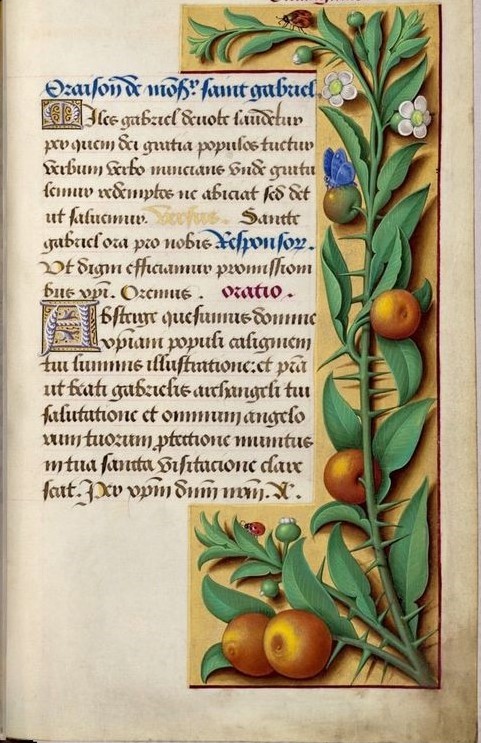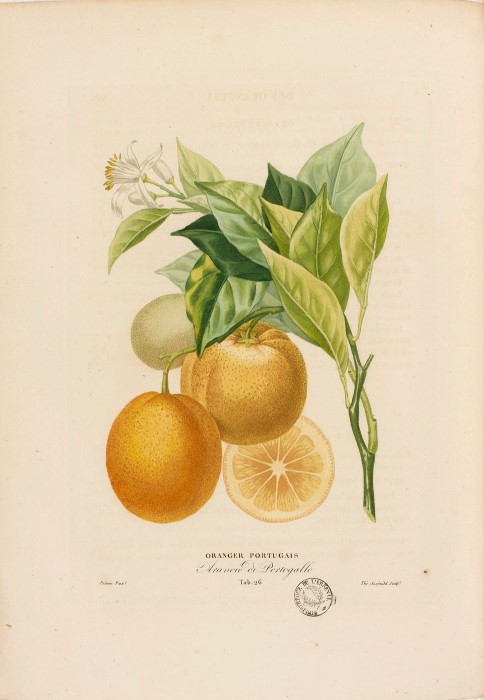
Oranges from Portugal
In the 19th century, the development of chemical medicine determined the end of the bitter orange, which will remain just as a rootstock or a decoration tree. The sweet orange tree starts to earn real protagonism and turns out to be an ingredient of several recipes. Other varieties of sweet oranges started to emerge, particularly the Bahia one, which will totally change the geography of production and the trade routes. But what was the journey of oranges before the great transformations of the 19th century?
The orange tree comes from Tropical and Subtropical South-East Asia and has been cultivated since ancient times throughout the Far East. During the first century b.c., in the Roman Empire, Dioscorides used the expression, malum aurantium, which means “golden-coloured fruit”, to define a fruit that didn’t exist in Europe but which was, probably, known from trade contacts with India. Later on, with the Arab expansion, the orange tree spread throughout the Mediterranean, and, if the Latin term aurum (gold) originated the word orange, which is based on vernaculars of France and England, the Asian Sanskrit name ñaranga, spreads with the name laranja or naranja in the Iberian Peninsula.
Bourdichon, Jean- Horae ad usum Romanum, dites Grandes Heures d’Anne de Bretagne. 1503-1508. Bibliothèque nationale de France . Manuscript.
From here it started to get disseminated through some Mediterranean regions, such as Malta and South of France, but it was in Portugal and Spain that the production expanded and became more valuable. The characteristic edaphoclimatic conditions of the Iberian Peninsula, especially the large number of hours of sunlight and ease of irrigation, allowed the orange tree to successfully adapt and grow leafy, in open soil, becoming, at the same time, space for leisure, flower and fruit production in many Portuguese gardens, in a concept that a garden can also be an orange orchard. In the specific case of Portugal, it was spreading through the landscapes of Minho, Douro, Coimbra, Lisbon and Setúbal, Azores and some places in Alentejo and Algarve. All over the country, they are also found in monastic enclosures and private gardens.
The bitter variety was privileged, more rustic, which tolerated the low temperatures well and had great advantages as a rootstock. At this time, in the early modern age and the following centuries, however, this tree had essentially a medicinal function valuing the leaves, peel and flower, from where oil and orange blossom water were extracted. The peel and the flower were also used to make some sweets that, in the same way, were used as medicines. The juice was used in the elaboration of some sauces that helped to preserve the cooked food, like escabeche, and in the composition of medicines too.
Portugal = orange
Nevertheless, in some regions of Portugal, under very specific climatic contexts, a variety of sweet-bitter oranges was developed, denominated bical. It probably justified its exportation to Europe and the Mediterranean, feeding a flourishing commercial activity that can go back to the Middle Age. This exportation gave origin to the dissemination of the word Portugal to designate the fruit itself. Terms like burtugal, used in the Arab world, portokali, in Greece, or portakal, in Turkey, are just some of the examples.
In the 18th century, Portugal brought from China a new variety of sweet oranges, that caused great enthusiasm throughout Europe, determining a huge flow of orange trees exportation from Portugal. The distribution of this Chinese variety around the world started to be designated, in Northern Europe and in Slavic lands, by a name that means chinese apple (pomme de chine in French), which created new name designations like apelsin and other similar ones.
RISSO A.; POITEAU, A. – Histoire naturelle des oranges. Paris: Audot, Libraire, éditeur de l’Herbier de l’ Amateur, du jardin fruitier, du bon jardinier, etc, 1818-1822.
In some botanists’ writings and agricultural treatises, we can also find this enthusiasm for orange, and in particular for the Portuguese orange, as a medicine product. In the 17th century, it was clearly expressed in Giovanni Battista Ferrari’s book, published in 1646, and in Joseph Pitton de Tournefort, in 1694, when they discoursed about the Lisbon orange (Olyssiponense aurantium), a variety that they distinguish from all the others. Still in this century, in 1692, the French men Ballon and Garnier, in a treatise on orange trees and citrus fruits, mention that the juice from Portuguese bitter oranges gives a wonderful taste to stews and other recipes; a great variety of sweets were made with it ( in a whole, or quarters, like the citrons, and orange blossom preserves); that if drunk in juice, with water and brown sugar were good to whet the appetite, especially on very hot days; that the peel squeezed into the wine, made it more pleasant and diuretic; that it was great for the stomach, liver, heart, brain, blood circulation, female reproductive system and to whet the appetite. At the end of the century, the Chinese variety, sweet, juicy and with a thin peel, was already circulating in Europe. However, the classic oranges from Lisbon, or Portugal, bitter or not very sweet, were still more successful.
Louis Lémery, botanist, chemist and professor at the Faculty of Medicine of the University of Paris, who published, in 1702, Traité des aliments (translated and adapted into English, in 1704, called Treatise of foods in general), will also tell us about this. In both texts, we can observe the great medicinal advantage of the bitter orange over the sweet that, besides other disadvantages, weakened the stomach. In the original version (French), the author refers to the oranges from Provence, Portugal, Nice, America and the China variety. However, according to the English edition (1704), it’s essentially addressed the existence in England of bitter oranges from Seville and sweet oranges of the Chinese variety, giving preference to the first ones.
In the following centuries, everything has changed. The sweet orange, the global orange trading and the juice preserved in packages, always present on the breakfast or snack table, are some examples of that. A different new era… nowadays, with the orange no longer as a medicine but as an irreplaceable and very valuable food ingredient.



0 Comments